US CAPITOL:
House:

The Senate and House chambers look very much alike. The main difference is that the House's chamber is larger because it needs to accommodate more than four times as many members as the Senate's.
The representatives' desks are fanned out around the area called the well. In the well is a rostrum with three tiers. The speaker's podium is on the middle tier, and the speaker's chair is on the top tier. The seats around the speaker are occupied by various clerks and the sergeant at arms.
The Democratic members sit on the left side of the room (to the Speaker's right), and Republicans sit on the right side of the room (to the Speaker's left). Independents sit with whichever party they caucus with.
https://www.thegreatcoursesdaily.com/washington-dc-capitol-building-and-the-legislature
The House of Representatives Chamber has 448 permanent seats. Unlike senators, representatives do not have assigned seats.
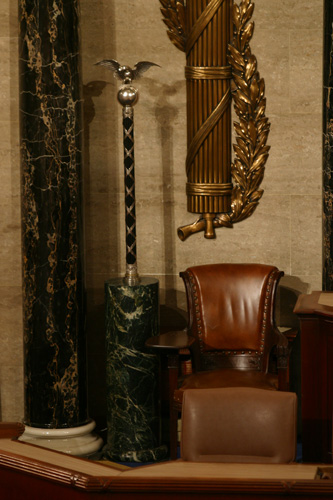 The Mace:
The Mace:The mace, the symbol of the authority of the House and of the office of the sergeant at arms, is in the custody of the sergeant at arms. At the opening of a session of the House, a staffer in white gloves places the mace on a pedestal to the Speaker's right. The mace is removed from its pedestal when the Committee of the Whole is meeting and moved to a lower, less visible position near the Speaker's dais. After consideration of amendments in the Committee of the Whole, the committee rises and reports the measure back to the House. The mace is replaced on its pedestal, and the Speaker or Speaker pro tempore assumes the chair.
It is 46 inches high and consists of 13 thin ebony rods representing the original 13 states of the union. The rods are bound together by four crossing ribbons of silver, pinned together and held at the bottom and at the top by silver bands. The bands are decorated with floral borders and a repousse design. The name "Wm. Adams/Manufacturer/New York/1841." is engraved in the cartouche, located in the front center of the bottom band. This shaft is topped by a silver globe 4-1/2 inches in diameter and engraved with the seven continents, the names of the oceans, lines of longitude, and the major lines of latitude. The Western Hemisphere faces the front. The globe is encircled with a silver rim marked with the degrees of latitude, on which is perched an engraved solid silver eagle with a wingspan of 15 inches. The total weight of the mace is 10 pounds.
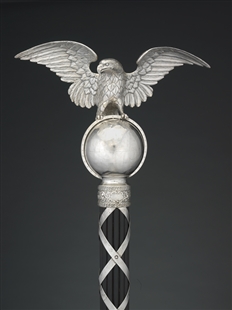
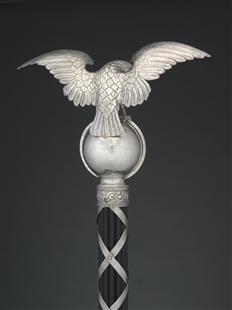
The Mace has been in use in the House since 1841 when the Members met in the old House Chamber. It was crafted by William Adams, a New York silversmith. The original mace had been destroyed when the British burned the Capitol in 1814, and during the intervening years, a wooden mace was used.
https://history.house.gov/Collection/Listing/2006/2006-162-000

In 1952, Cox was selected to finish the "Frieze of American History" in the Capitol Rotunda begun in 1878 by Constantino Brumidi and continued by Filippo Costaggini after Brumidi's death. He restored the original portion of the frieze and designed and painted three scenes that filled a gap that had existed since 1889.
In 1969, he began research and preliminary sketches for the first of the three corridors now fondly known as the Cox Corridors. He began painting the first corridor, the Hall of Capitols, in February of 1973 and completed it in July 1974. This corridor has been termed the Hall of Capitols because it features paintings of the sixteen different buildings that housed the Continental and United States Congresses from 1754-1885.
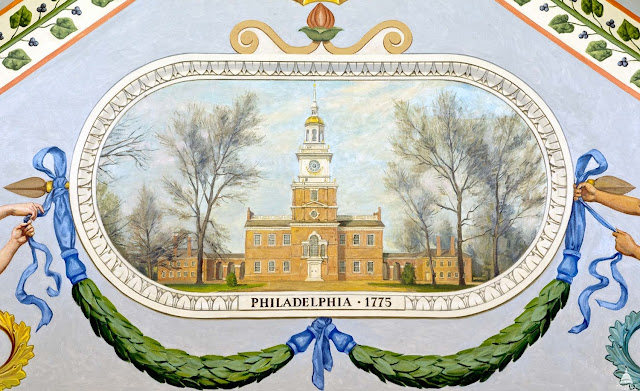
The second corridor required the assistance of Cliff Young and was completed shortly before Cox's death in 1982. Unfortunately Cox passed away prior to work on the third corridor, known as the Westward Expansion corridor. Cox had already completed the drawing; however, the painting of the corridors was done by Evergreene Painting Studios in 1993 based on Cox's approved design.

This room in the United States Capitol was constructed between 1815 and 1819 as the House of Representatives chamber. However, the House had actually met here at this site since 1801, when a temporary structure was built here while the Capitol was still under construction. This was replaced by a permanent House chamber in 1807, but this was subsequently burned during the British invasion of Washington in 1814. It was soon rebuilt, though, with designs by architects Benjamin Henry Latrobe and Charles Bulfinch.
The room is semicircular, and shaped like an ancient amphitheater. It is surrounded on all sides by locally-quarried marble columns, which are topped by white marble Corinthian capitals that were imported from Italy. The original design of the room also included two statues, both of which are still here. One is located directly behind where this photo was taken from, and the other, Liberty and the Eagle, is visible above the columns in the center of the room. It was the work of sculptor Enrico Causici, and it features a female depiction of Liberty, holding the Constitution in her outstretched right hand. To her right is an eagle, and to the left is a snake on a column.
The House of Representatives met here until 1857, when the present House chamber was completed. In 1864 this room was designated as the National Statuary Hall, and each state was invited to send two statues of prominent individuals from their history. Over time, as the collection of statues grew, this room became too overcrowded. The dozens of heavy statues also raised structural concerns, so many of them were ultimately relocated to other parts of the Capitol.
Today, there are 38 here in Statuary Hall, although only three of the ones visible in the first photo are still in this room. Of these, only Lewis Cass is still visible from this angle, with his statue standing between the two columns on the left, only a few feet from where it stood a century earlier in the first photo. One of the statues from the first photo, William Allen, has been entirely removed from the Capitol; his statue was replaced in 2016 by one of Thomas Edison.
https://lostnewengland.com/2019/10/statuary-hall-us-capitol-washington-dc

Behind an unmarked door in the U.S. Capitol, camouflaged by the opulent marble figures in Statuary Hall, lies a special space unknown to most passersby. After tapping a secret code into a security keypad, the door opens into a small reception area and a suite of rooms exclusively for the use of women members of the United States House of Representatives.
The Lindy Boggs Reading Room provides women lawmakers with their own private retreat from the rest of the Capitol.
The Reading Room is the only bipartisan meeting space in the Capitol building dedicated to women members.
https://www.salon.com/2013/08/04/americas_most_powerful_powder_room
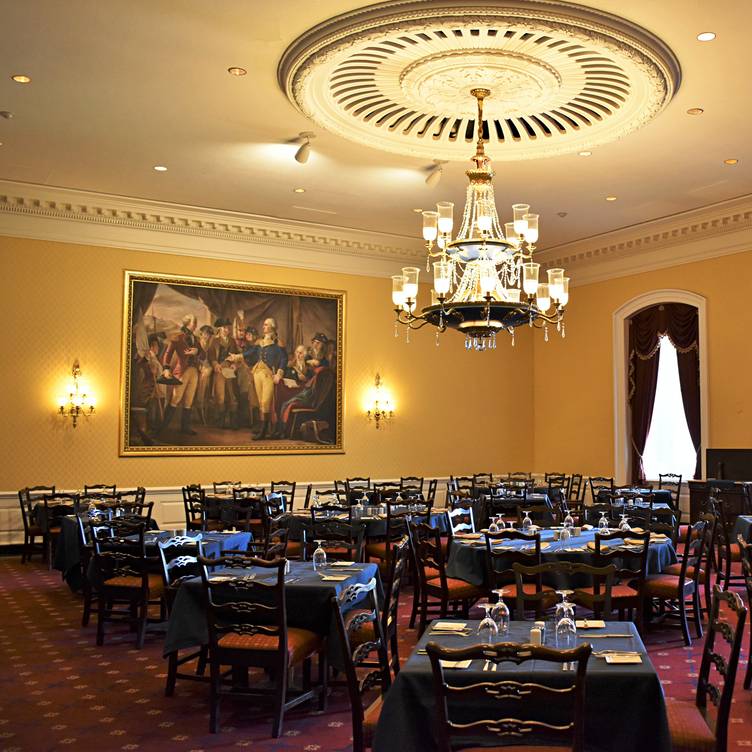
Located in Room H117 of the Capitol Building.
https://www.opentable.com/r/members-dining-room-at-us-house-of-representatives-washington
As far back as 1834, Congress made arrangements for food and drink in the Capitol. The relatively undeveloped neighborhood and Congress's regimented work schedule made the availability of food on site a necessity. In a room referred to as the "refectory," local restaurateurs served menus of popular favorites.
The two largest dining rooms are named for Ernest S. Petinaud and Charles E. Bennett. Ernest Petinaud immigrated to the United States from Jamaica in the 1920s, when he first worked in the Members' Dining Room as a busboy. He retired as head waiter in 1973, and the space on which he left his mark was named for him. Representative Charles E. Bennett worked in the Capitol almost as long, serving 44 years, outlasting any other Floridian Representative in the House. The chandeliers he donated to the House of Representatives in 1991 decorate the room that bears his name.
https://history.house.gov/Exhibitions-and-Publications/Capitol/Members-Dining-Room
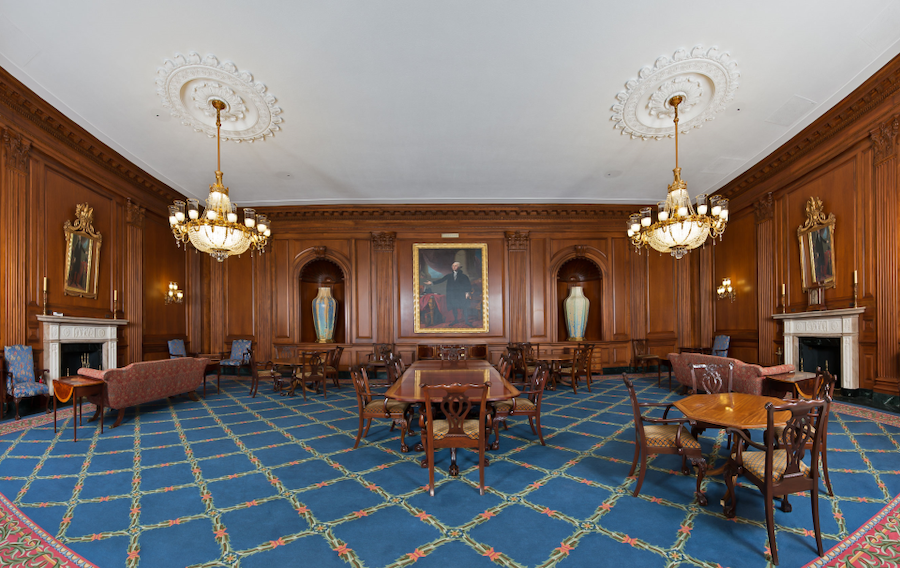
Just across from the Democratic Cloakroom, the Rayburn Reception Room is a relative newcomer to the Capitol. It was completed in 1962 as part of the East Front extension and dedicated to Speaker Sam Rayburn, who promoted the building project. The House side of the Capitol long lacked a reception room where Members could meet with press or receive constituents.
Although the space is modern, the historic spaces of the Capitol inspired the design and decor. Like the House Chamber, which was remodeled more than a decade earlier, walnut paneling is the dominant material. The room is ringed with a carved entablature. Below it, Corinthian pilasters divide the wall space. On the south wall, the House dictated niches for the Sevres vases and a space between them for the newly acquired George Washington portrait.
https://history.house.gov/Exhibitions-and-Publications/Capitol/Rayburn-Reception-Room
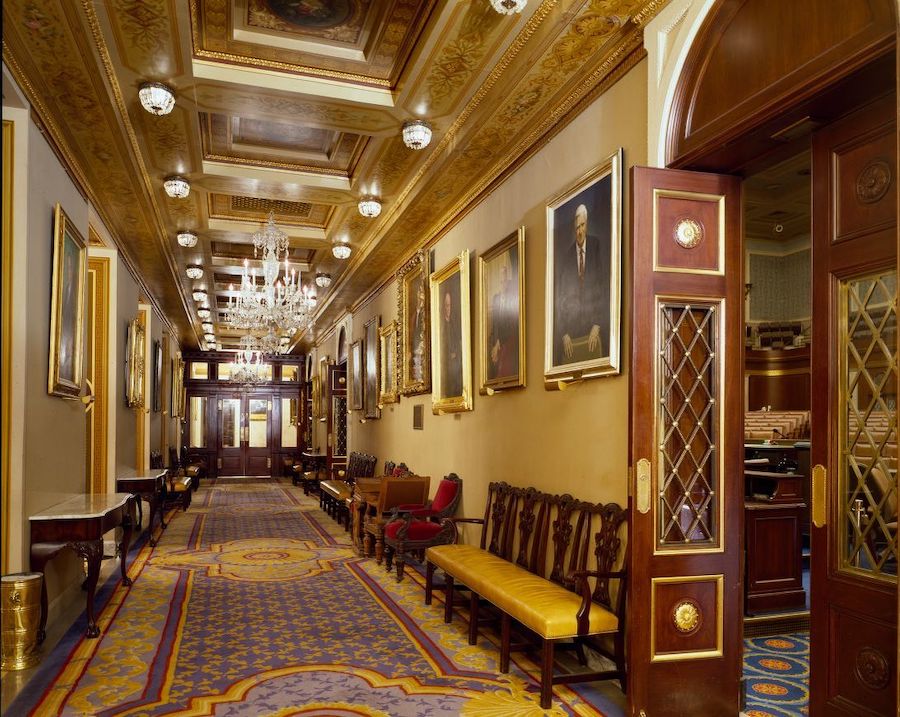
Portraits of the speakers of the House of Representatives line the wall of the Speaker's Lobby, just outside the House chamber.
https://www.loc.gov/resource/highsm.13419/?r=-0.127,-0.005,1.269,0.885,0
The creation of the airy, stately space known as the Speaker's Lobby and Members' Retiring Room was motivated not by a need for mingling room, but for ventilation. The open rooms just outside the House Chamber that are now the Speaker's Lobby and the Members' Retiring Room were initially divided in three, housing a Post Office and individual offices for the Speaker and the Sergeant at Arms. In 1879, though, Members' complaints about the lack of fresh air in the House Chamber prompted a remodeling. Walls were removed, opening up the three offices into a contiguous space with an east-facing balcony. With all the doors thrown open, a breeze could penetrate the House Chamber.





